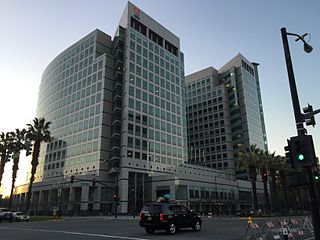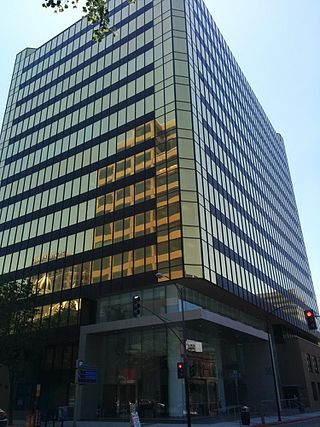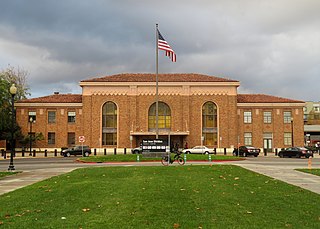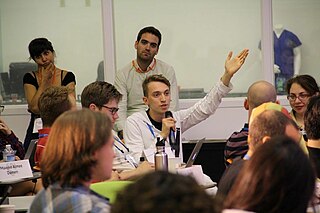Related Research Articles

Fiber Distributed Data Interface (FDDI) is a standard for data transmission in a local area network. It uses optical fiber as its standard underlying physical medium.

A metropolitan area network (MAN) is a computer network that interconnects users with computer resources in a geographic region of the size of a metropolitan area. The term MAN is applied to the interconnection of local area networks (LANs) in a city into a single larger network which may then also offer efficient connection to a wide area network. The term is also used to describe the interconnection of several LANs in a metropolitan area through the use of point-to-point connections between them.
In computer networking, peering is a voluntary interconnection of administratively separate Internet networks for the purpose of exchanging traffic between the "down-stream" users of each network. Peering is settlement-free, also known as "bill-and-keep" or "sender keeps all", meaning that neither party pays the other in association with the exchange of traffic; instead, each derives and retains revenue from its own customers.
A competitive local exchange carrier (CLEC), in the United States and Canada, is a telecommunications provider company competing with other, already established carriers, generally the incumbent local exchange carrier (ILEC).

UUNET Technologies, Inc., formerly UUNET Communications Services, was an American commercial Internet service provider. Founded in 1987, it was one of the first and largest commercial ISPs and one of the early Tier 1 networks. It was based in Northern Virginia. Today, UUNET is an internal brand of Verizon Business.
Internet exchange points are common grounds of IP networking, allowing participant Internet service providers (ISPs) to exchange data destined for their respective networks. IXPs are generally located at places with preexisting connections to multiple distinct networks, i.e., datacenters, and operate physical infrastructure (switches) to connect their participants. Organizationally, most IXPs are each independent not-for-profit associations of their constituent participating networks. The primary alternative to IXPs is private peering, where ISPs directly connect their networks.

Downtown San Jose is the central business district of San Jose, California, United States. Downtown is one of the largest tech clusters in Silicon Valley, as well as the cultural and political center of San Jose.
The MAE was the first Internet Exchange Point (IXP). It began in 1992 with four locations in Washington, D.C., quickly extended to Vienna, Reston, and Ashburn, Virginia; and then subsequently to New York and Miami. Its name stood for "Metropolitan Area Ethernet," and was subsequently backronymed to "Metropolitan Area Exchange, East" upon the establishment of MAE-West in 1994. The MAE predated the National Information Infrastructure plan, which called for the establishment of IXPs throughout the United States. Although it initially had no single central nexus, one eventually formed in the underground parking garage of an office building in Vienna, VA.
A meet-me room (MMR) is a place within a colocation center where telecommunications companies can physically connect to one another and exchange data without incurring local loop fees. Services provided across connections in an MMR may be voice circuits, data circuits, or Internet Protocol traffic.

Tower 55 is a 15-story building at the corner of South Market Street and Post Street in downtown San Jose, California. Built in 1985 as the Market Post Tower, it was designed to provide a mix of office and retail space. When first built, the building was controversial due to its gold-colored glass exterior, which produced high light and heat reflection. In its early years, the owners struggled financially with the property and were forced to put it up for sale in 1987. While the intended tenants did not materialize, the building proved popular with telecom carriers as an Internet exchange center, with MAE-West on the 13th floor, one of the oldest and most well known Internet exchanges. Many carriers maintain collocation space in the building to support their interconnections through MAE-West as well as direct interconnections.

San Jose Diridon station is the central passenger rail depot for San Jose, California. It also serves as a major intermodal transit center for Santa Clara County and Silicon Valley. The station is named after former Santa Clara County Supervisor Rod Diridon Sr.
MFS Communications Company, Inc. was a competitive local exchange carrier that owned and operated local network access facilities installed in and around major U.S. cities and several major European cities. MFS also possessed significant transmission and switching facilities and network capacity that it leased from other carriers in the United States and Western Europe.

The media in the San Francisco Bay Area has historically focused on San Francisco but also includes two other major media centers, Oakland and San Jose. The Federal Communications Commission, Nielsen Media Research, and other similar media organizations treat the San Francisco-Oakland-San Jose Area as one entire media market. The region hosts to one of the oldest radio stations in the United States still in existence, KCBS (AM) (740 kHz), founded by engineer Charles Herrold in 1909. As the home of Silicon Valley, the Bay Area is also a technologically advanced and innovative region, with many companies involved with Internet media or influential websites.

San José City Hall is the seat of the municipal government of San Jose, California. Located in Downtown San Jose, it was designed by Pritzker Prize-winning architect Richard Meier in a Postmodern style. It consists of an 18-story tower, an iconic glass rotunda, and a city council chamber wing, laid out within a two-block-long public square known as San José Civic Plaza. The tower rises 285 feet (87 m) above the plaza, making it the fourth tallest building in San Jose.

NASA Research Park is a research facility under the auspices of NASA located in San Jose, California. It is focused on fostering collaboration among government entities and academic institutions.

Santa Clara County, officially the County of Santa Clara, is the sixth-most populous county in the U.S. state of California, with a population of 1,936,259 as of the 2020 census. Santa Clara County and neighboring San Benito County form the San Jose–Sunnyvale–Santa Clara metropolitan statistical area, which is part of the larger San Jose–San Francisco–Oakland combined statistical area. Santa Clara is the most populous county in the San Francisco Bay Area and in Northern California.
Google Fiber, sometimes stylized as GFiber, is a fiber broadband Internet service operated by Google Fiber Inc., a subsidiary of Alphabet, servicing a growing number of households in cities in 19 states across the United States. In mid-2016, Google Fiber was estimated to have about 453,000 broadband customers.

The Makati Central Business District is a privately-owned financial and central business district in the Philippines located in the heart of Makati in Metro Manila. It is politically and administratively known as "Central Cluster" in the West District of Makati. It is different from the Makati civic center known as "Makati Poblacion" which is situated at the northeast portion of the district. It is bounded by EDSA, Amorsolo Street, Ayala Avenue, Gil Puyat Avenue, Osmeña Highway, South Luzon Expressway, Metro Manila Skyway, Zobel Roxas Street, Ocampo Street, Metropolitan Avenue, Nicanor Garcia Street, Kalayaan Avenue, Makati Avenue, Anza Street, Polaris Street, Orion Street, Mercedes Street, Amapola Street and Estrella Street. The whole district occupies barangays of San Antonio, San Lorenzo, Bel-Air, and Urdaneta.

Cologix, a network neutral interconnection and data center company, runs 40+ interconnection locations across 11 North American markets. The edge markets that Cologix operates in are: Columbus, Ohio; Dallas, Texas; Jacksonville, Florida; Lakeland, Florida; Minneapolis, Minnesota; Montreal, Quebec; Silicon Valley, California; Toronto, Ontario; Northern New Jersey; and Vancouver, British Columbia. The company supports five Internet exchanges.
References
- ↑ Hardie, John (15 November 1994). "MAE-West" (PDF). Metropolitan Fiber Systems.
- ↑ Garfinkel, Simson (11 September 1996). "Where Streams Converge" (PDF).
- ↑ "Southern Cross Cable Network commissions third US access point". The Age . August 19, 2002.
- ↑ "MAE West". MAE.net. 1998. Archived from the original on February 2, 1999. Retrieved February 1, 2017.
- ↑ Learmonth, Michael (April 22, 1999), "Hubba Hub", Metro Silicon Valley, retrieved February 1, 2017